By Carol Woodbridge Mulder © 1991
** Originally published in the April 1991 issue of The Crabbet Influence magazine. Also published in The Crabbet Influence's 1993 Collector's Volume II.
The Kellogg Ranch at Pomona, California, was six years old in 1931 and the foal crop of that year was the seventh to be foaled at the ranch; the first foal crop, of 1925, had been in-utero purchases. Eighteen registered foals arrived in 1931. While these animals were bred by W.K. Kellogg, they actually reflected the breeding ideas and policies of the Kellogg Ranch manager, Herbert H. Reese. The quality of the foals was more than gratifying in most cases. A roster of the 1931 Kellogg foal crop follows:
Rifnada 836 (Hanad 489 x *Rifda 605) chestnut mare bred by Kellogg Ranch, sold about 1942
Ferdana 840 (*Ferdin 613 x *Rossana 598) grey mare bred by Kellogg Ranch, gift 12-1-1948
Ronek 807 (*Raseyn 597 x Bahreyn 603) grey stallion bred by Kellogg Ranch, sold 1931
Ferdas 841 (*Ferdin 613 x *Rasima 606) chestnut stallion bred by Kellogg Ranch, sold young
Danas 842 (*Nasik 604 x *Ferda 596) chestnut mare bred by Kellogg Ranch, sold 4-17-1937
Antarah 834 (Antez 448 x Hasiker 268) bay mare bred by Kellogg Ranch, sold about 1933
Raidaana 830 (Jadaan 196 x *Raida 600) grey mare bred by Kellogg Ranch, destroyed 9-8-1944
Adounad 833 (Hanad 489 x Adouba 270) bay stallion bred by Kellogg Ranch, sold at maturity
Hasab 835 (Hanad 489 x Saba 437) chestnut stallion bred by Kellogg Ranch, sold March 1935
Binad 831 (Hanad 489 x *Bint 608) bay stallion bred by Kellogg Ranch, died 12-29-1931
Ferdasafa 838 (*Ferdin 613 x *Rasafa 602) chestnut mare bred by Kellogg Ranch, sold April 1933
Schantez 832 (Antez 448 x Schilla 419) chestnut stallion bred by Kellogg Ranch, sold about 1937
Nafara 839 (*Nasik 604 x *Farasin 615) bay mare bred by Kellogg Ranch, sold about 1933
Moreyn 828 (*Raseyn 597 x Monica 589) bay stallion bred by Kellogg Ranch, sold about 1937
Amaana 837 (Jadaan 196 x Amham 410) grey mare bred by Kellogg Ranch, sold about 1937
Jadura 829 (Jadaan 196 x Sedjur 193) grey mare bred by Kellogg Ranch, sold about 1933
Maras 871 (*Raseyn 597 x Sanma 411) bay stallion bred by Kellogg Ranch, sold about 1933
Ilmilad 875 (Hanad 489 x *Ferdisia 595) chestnut stallion bred by Kellogg Ranch, sold at maturity
The chestnut filly Rifnada, foaled on January 21, was the first foal of the year. She was marked with a narrow blaze, left front partial coronet, right front stocking, and left hind stocking. Attractive, breedy, and of good quality, she was retained in the Kellogg broodmare band until about 1942 when she was 11; at that time it appears that she was sold. Rifnada had produced four foals for Mr. Kellogg from 1936 through 1941. Her 1937 daughter, Famada 1442, a bay by Farana 708, was considered one of the best and most beautiful of her year. Rifnada produced a 1949 colt for J.B. Kirk of Rogue River, Oregon. Her last two foals were bred by Victor E. and Trylvia L. Oppengard, Anaheim, California. Rifnada was 23 at the birth of her final foal in 1954.
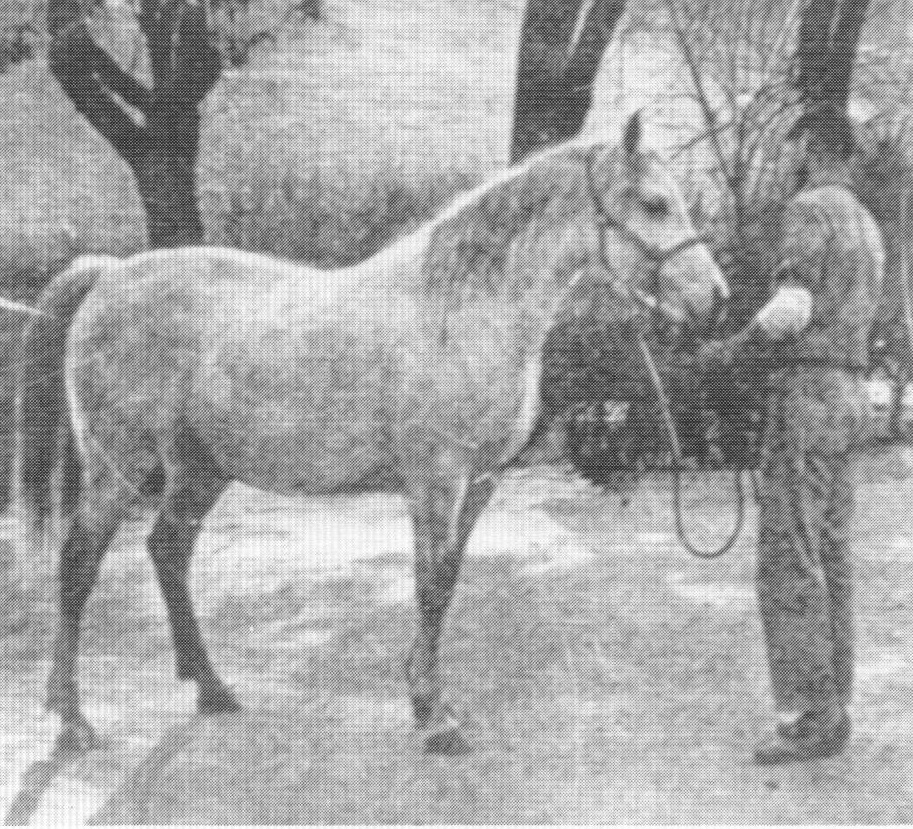
Ferdana, an exquisitely beautiful mare with a gorgeous head, was of both extreme classic type and great correctness. She, also, was retained at the Kellogg Ranch as a broodmare. A gray foaled February 5, she was marked with an irregular strip terminating over her right nostril, a white spot on her underlip, left front pastern, and left hind coronet. Ferdana was a favorite of both Kellogg personnel and ranch visitors; many felt she was among the very best mares at the stud. Ferdana also had a very sensible and sweet disposition. In his book, The Kellogg Arabians, Their Background and Influence, Herbert H. Reese wrote of Ferdana:
"...Like *Rossana,...., she had a fine disposition, apparently afraid of nothing, as the following incident illustrates. During the San Diego Worlds Fair, when the ranch was supplying horses for the Days of Saladin pageant, an additional Arab was needed to stand on a platform in front of the pavilion to draw attention to the show. Ferdana, a two-year-old at the time, was about the only suitable horse available, so was taken directly out of pasture, rushed to the show, and hurriedly introduced to her new job. She tool to the work like a veteran, and in spite of her youth, and the fact that she had never been out of her home pasture before, she never became frightened at the blaring noise from the midway attractions, the blinding lights at night, or from the milling crowds. Her typical Arabian beauty, symmetry and poise made her ideal for this particular duty..."
Ferdana produced a total of eleven foals. Nine of them were bred by the Kellogg Ranch. Her produce were usually of outstanding quality. Among them were such fine animals of yesteryear as Sahm 1524, 1938 chestnut stallion by Rifnas 924; Anaga 1954, 1940 chestnut mare by Rabiyas 1236; Masala 2338, 1942 gray mare by *Raseyn 597; Pomona Astral 2987, 1944 bay mare by *Raseyn; Sedan 3823, 1946 bay gelding by *Raseyn; Ramly 4833, 1948 gray stallion by Rabiyas 1236; and Rose of Rossana 5862, 1949 gray mare by Alyf 1465.
On December 1, 1948, when she was 17 years old, Ferdana was chosen to go as a gift to the University of Idaho, Moscow, Idaho, which bred two more foals from her, her last one foaled in 1952 when she was 21.
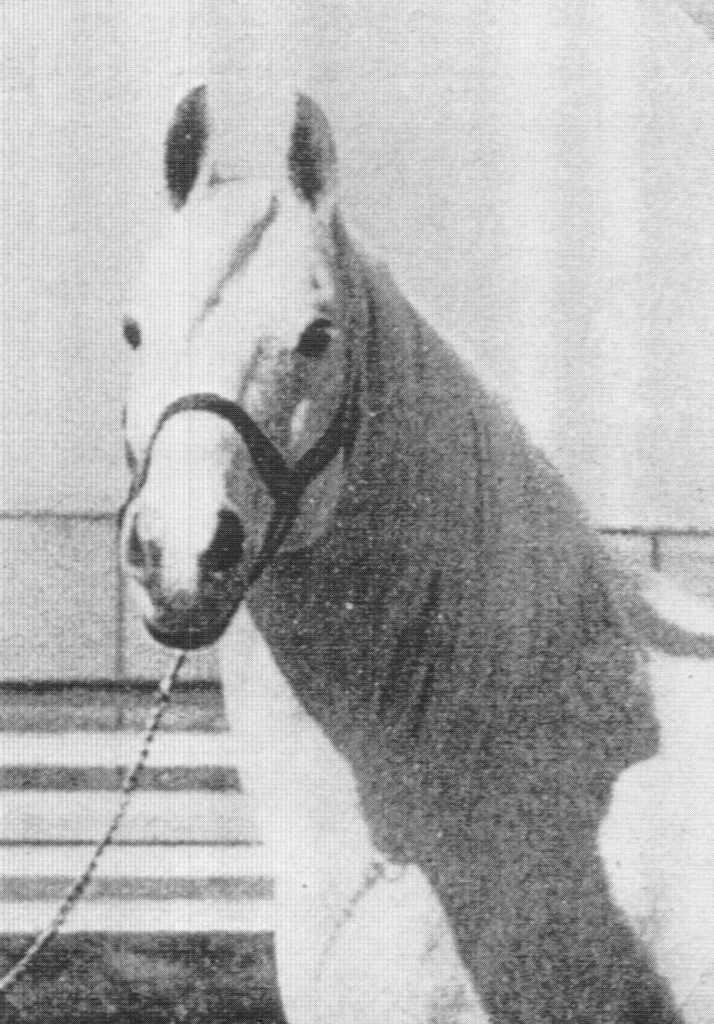
Ronek, a gray foaled February 21, apparently was a colt of considerable attraction. He sold as a weanling in 1931; this was at a time when the Great Depression was curtailing sales.
His first two seasons at stud were at J.M. Dickenson's Travelers Rest Stud, Franklin, Tennessee. Eight 1938 foals and four 1939 foals resulted. Among them were some truly outstanding animals including Bride Rose 1462, 1938 gray mare x *Rose of France 857; Alyf 1465, 1938 gray stallion x Fath 583; Hawija 1469, 1938 bay mare x Ghazil 635; and Gym-Faras 1470, 1938 gray mare x Guemera 277.
It appears that Ronek was next at the farm of Donald L. Jones, Porterville, California, where he was used at stud for two years. Eleven 1940 and 1941 foals were registered, among them Gayr 1942, 1940 brown stallion x *Barakat 1218; Faronek 2058, 1941 chestnut stallion x Farhan 684; Rasul 2059, 1941 chestnut gelding x Tranzah 1062; and Marobi 2154, 1941 bay mare x Mabruk 534.
It seems that Ronek was in Washington and/or Oregon for the next eight years. During that time he got 14 foals for six different breeders including R.B. Field. Als Ronek 4237, 1947 gray stallion x Albricias 1792, was one of these Ronek get.
It seems to have been about 1949 when Ronek returned to California at the age of 18. He spent the rest of his life in the state of his birth. During this phase of his life he sired another 25 foals bred by several different people including Mr. and Mrs. L.E. Mekeel, Dr. and Mrs. H.K. Dowdy, John M. Rogers, Alice M. Bracker, M.W. Peddicord, and John B. Logvy. Among the Ronek get from this period were Risab 6054, 1950 gray stallion x Fadahma 1245; Al-Hakim 8766, 1953 gray gelding x Rafaya 10245; Al-Zeyn 9864, 1955 gray stallion x Rasarah 2131; Bint Rasoulma 10245, 1955 gras=y mare x Rasoulma; Roma 10642, 1956 gray mare x Jubilema 4417; Hami Husan 10876, 1956 gray mare x Sahagay 4468; Bint Ronek 10908, 1956 bay mare x Pomona Avesta 2991; and Fal-Ronek 11652, 1956 gray stallion x Fyla 11650.
Ronek's last season at stud was 1955 when he was 24 years old. Altogether he sired 62 registered purebred foals. He was a sire of capability; several of his sons and daughters were outstanding. He usually transmitted classic type and beauty to his get. His hallmark, however, was his ability to give very strongly his own brilliant trot which he, in turn, inherited from his dam.
Ronek was a beautiful horse of classic type. He had great style. His face and ears were particularly old-style Arab; he had great width between his eyes and his fine, small ears pointed toward each other at their tips. It appears that he probably inherited his sire's natural amble - or pace or singlefoot - or whatever it was. In any case, Ronek was one of the very rare Arabs trained five-gaited. It is usually easier to gait horses who display a natural tendency via an inherited amble.
Ronek was, indeed, one of the important sires of his era.
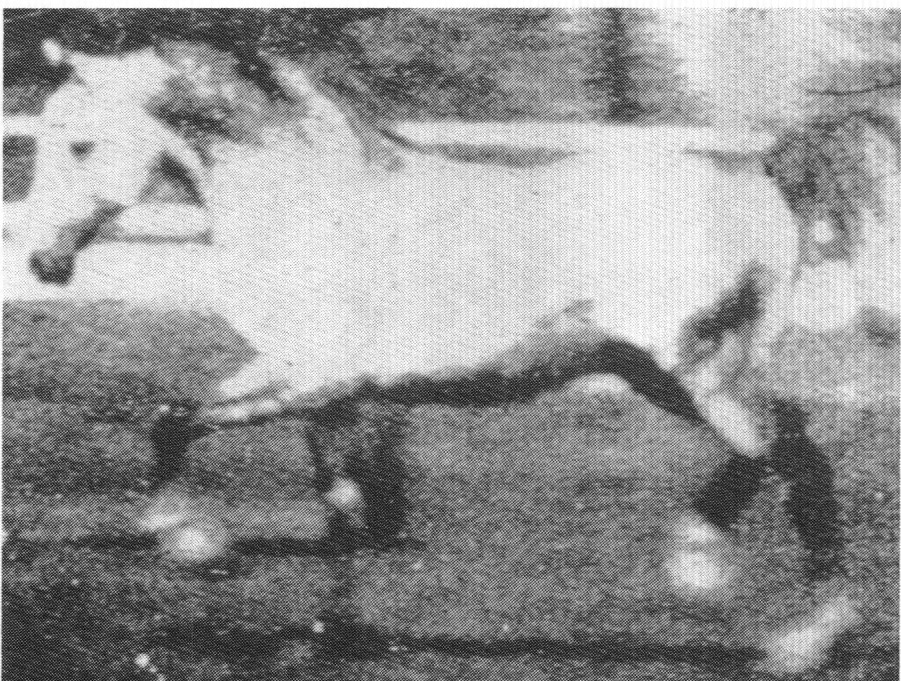
The chestnut colt, Ferdas, foaled March 7, was a most handsome individual. He was marked with a blaze, left hind stocking, and right hind partial fetlock. He was sold as a young adult to Myrtle Warren, Wilmette, Illinois. He left no progeny.
On March 11 the chestnut filly Danas was foaled. She was marked with a star, race, and unconnected small snip, left front fetlock, and left hind stocking. A very attractive individual, she produced her only recorded foal for Mr. Kellogg in 1936. She was sold April 17, 1937, at age 6, to Roberto Garcia, Mexico City, Mexico.
Antarah, a bay filly foaled March 17, was marked with an irregular strip, left hind sock, and right hind fetlock. She was sold about 1933, when about 2 years of age, to J.G. MacConnell, La Canada, California. She produced a total of 13 foals, the first seven of them, foaled between 1935 and 1947, bred by Mr. MacConnell. Her 1949 filly was bred by John W. Douthit, Jr., Covina, California.
Her next three foals were bred by John J. Sullivan, M.D., Oakland, California. Her last two foals were bred by Victor E. Chesky, Jr., Halstead, Kansas. Antarah was 25 years old at the birth of her final foal in 1956. Time has proven Antarah to have been an important matron, particularly to the modern 'straight' Davenport breeding group. Among her produce were such quality animals as Aneysa 1139, 1935 bay mare by Farana; Dharanah 2674, 1942 gray mare; El Alamein 2676, 1943 chestnut stallion; Dharebah 3848, 1946 gray mare; and Dharantez 4455, 1947 gray stallion. The last four named were all sired by Dhareb 537.
The gray mare Raidaana was foaled April 4. She was marked with only a small star. Raidaana was retained for the Kellogg broodmare band where she produced eight quality foals between 1937 and 1944. Among them was Daanaseyn 1766, 1939 gray mare, and Pomona Ahrany 2989, 1944 gray mare, both sired by *Raseyn. Raidaana was put down September 8, 1944, at age 13, due to painful ringbones.
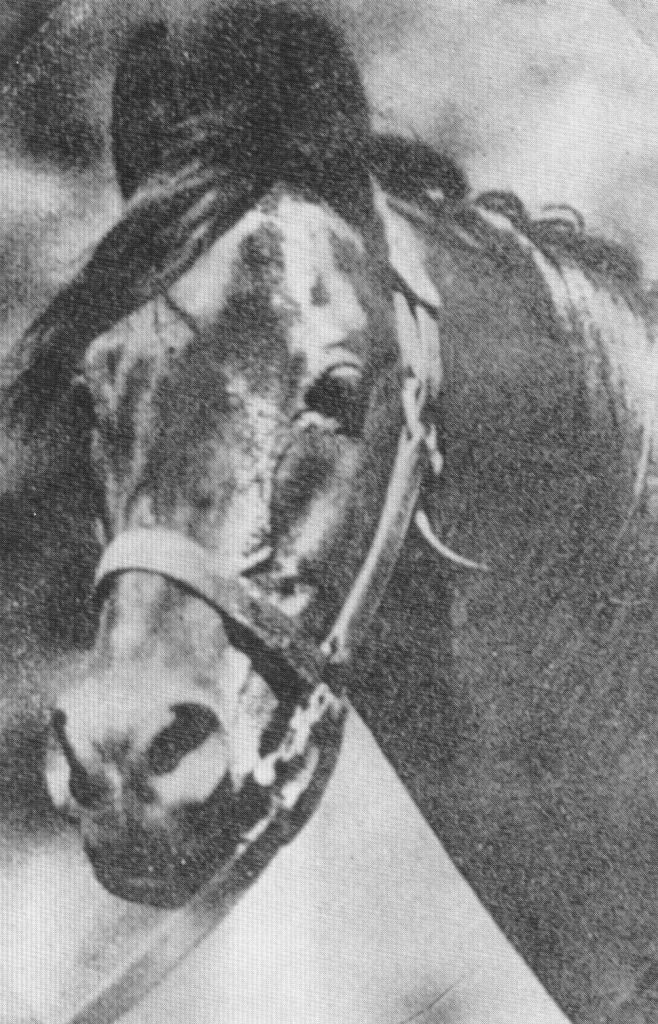
The beautiful and stylish bay stallion Adounad was foaled April 6. His markings were a small star and right hind fetlock. He was sold at maturity to Charles J. Taylor, Vancouver Island, British Columbia, Canada. It was not until 1952, when Adounad was 21 years of age, that he was given his first opportunity to sire purebred foals. He ultimately got a total of eight foals born between 1953 and 1958. All were bred in Canada. Adounad died in 1959 at the age of 28.
Hasab, chestnut stallion, was foaled April 15. A handsome horse, he was marked with only a star. His first foal, bred by W.K. Kellogg Institute, was Raiaba 1187, 1935 chestnut mare x *Raida 600. Hasab was sold in March of 1935, at almost 4 years of age, to Mrs. Beverly Young, Arvin, California. Altogether, Hasab sired 16 purebred registered foals, the last two, foaled in 1947, conceived in 1946 when he was 15 years old. Perhaps the best known of his get was Hasarip 3025, 1944 chestnut stallion x Ripples 818.
The unfortunate bay colt Binad was foaled on April 28. He was marked with a prolonged star, small snip, and four white fetlocks. Binad died December 29, 1931, from what was diagnosed as an intestinal infection. He was only eight months old.
June 24 brought the birth of the chestnut filly Ferdasafa. Her markings were an irregular blaze, right front three-quarter stocking, and both hind stockings. She was sold in April of 1933, just two months short of turning two years old, to W.R. Hearst for his San Simeon, California, stud. Hearst bred three foals from Ferdasafa; included among these was the important Rehasafa 1269, 1936 chestnut mare by Rehal 504. Ferdasafa seems next to have been owned by Leo P. Musser, Lafayette, California, who bred her 1940 and 1941 foals from her. Frank H. Porter, Hayward, California, was the breeder of her 1945 filly. It appears that Ferdasafa's last owners were D.H. and K.B. Linderman, Clementsville, Idaho, who were the breeders of her last two foals. Ferdasafa was 19 at the birth of her final foal in 1950; she had produced a total of eight.
On June 28 the chestnut colt Schantez was foaled. He was marked only with a small irregular star. He was an outstanding horse and the Kellogg Ranch was in no hurry to sell him, but finally, about 1937, when he was 6, he was sold. Before he left the ranch one mare was bred to him and so his forst foal was Kellogg-bred. Schantez, who got only six foals in his life between the 1937 and 1944 stud seasons, sired his second foal for Channell T. Libbey of Livingston, Montana. His next three foals were bred by Fred E. Vanderhoof, Woodlake, California. Schantez's last foal, which arrived in 1945, was bred by Mrs. Jake L. Hamon, Dallas, Texas; Schantez was only 14 years old when this daughter was conceived. His best known get were Rantez 2064, 1941 chestnut stallion, and Kafi 2453, 1942 gray mare, both out of Rasrah 865.
The bay filly Nafara was foaled on July 15. She was marked with a large star, a snip, and right hind pastern. She was sold in April of 1933, when still a yearling, to W.R. Hearst who owned her during her entire productive life. Nafara became dam of five foals. Time has proven her son Narzigh 1745, 1939 chestnut by Ghazi 560, to have been a horse of some influence. His name appears today in the pedigrees of many fine Crabbet/American Arabians, mostly through his grandson Aurab 12488.
July 30 brought the birth of Moreyn, a bay colt marked with an irregular strip, right front fetlock, left hind partial fetlock, and right hind sock; there were sizable black dots on his rear coronary bands within the white markings. This horse appeared in the Kellogg Sunday afternoon exhibitions in the 'tribesman raider' act. He carried a rider dressed in authentic Arab attire and galloped full-speed around the show ring. The audience loved this fast display. Moreyn was sold about 1937, when he was about 6 years old, to Mrs. M.S. Le Vin, Allentown, Pennsylvania. He got only one foal in his life, conceived when he was 14 years old. Foaled in 1946, this filly, Reba 3914, x Berle 1021, was bred by George L. Wirtz, Kutztown, Pennsylvania.
There were no more foals at Kellogg's until September 10 when Amaana arrived. This gray filly was marked with a star and four white pasterns. Kellogg records show that she, too, was sold to Miriam Le Vin along with Moreyn, but the sale either did not go through or Mrs. Le Vin quickly resold her because Amaana seems not to have left California. In any case, the first of her eight foals was bred by the Kellogg Ranch. This was Rafa 1257, 1936 gray mare by *Raseyn. Rafa was one of the admired mares of her day. Amaana's next two foals - of 1939 and 1941 - were bred by H.I. Tupman, Bakersfield, California. Her next owners appear to have been Mr. and Mrs. G.A. Cooper, Tarzana, California, who bred two foals from Amaana. One of these was Waddaana 4610, 1948 gray mare by Barak 2494. Amaana's last owner seems to have been Vilma A. Martin, Romoland, California, who bred three foals from her, the last foaled in 1952 when Amaana was 21 years old. One of these foals was El Rahnason 5333, 1949 gray stallion by El Rahan 1861. A horse of outstanding quality and symmetry, El Rahnason also possessed extremely classic Arabian type and great beauty. When young, he was of that rare shade of gray which displays even dappling with snow-white mane and tail. This lovely horse was well known in his day as a show and parade Arabian in southern California. Amaana died April 8, 1955, at age 23. Like many of the Jadaan daughters, Amaana clearly had superior production capability.
Jadura was foaled on October 10. This gray filly was marked with an irregular blaze not connected to white spot on upper lip, and both right fetlocks. She was sold about 1933, when she was about 2 years old, to J.M. Dickinson, Franklin, Tennessee. Her only foal, a colt, was produced in 1935 when she was 4 years old. Najadur 1111, a gray by *Nasr 889, was bred by John Ekem Ott, Chicago, Illinois.
Maras, a bay colt, was foaled on December 6. He was marked with a star, race, and snip with one white pastern and one white coronet. He was sold from the Kellogg Ranch about 1933, when he was about 2 years of age, to H.B. Lake, Great Falls, Montana. He sired no purebred registered foals.
The last Kellogg foal of 1931 was the chestnut colt Ilmilad, foaled December 25, Christmas Day. He was marked with a star, race, and larger snip, right front pastern, left hind fetlock, and right hind sock. Ilmilad was used for riding at the Kellogg Ranch and was much liked there, although his head was considered too plain to breed from him. He was sold after his full maturity and during his life got four foals; the first of these was foaled in 1940 and the next three in 1950. Their breeders were all Californians - Woodworth Clum of Los Angeles, J.J. Wilson of San Mateo, and Stephen Bonovich of Rodeo.
It is apparent that the young Kellogg Ranch was producing quality Arabians whose lasting and very important influence was being widely disseminated throughout the United States and into many different ongoing breeding programs where the blood is still much appreciated today due to the long term results.
While I cannot reconstruct with total precision the Kellogg Ranch Arabian horse inventory for December 31, 1931, I believe I have done it with very close accuracy.
It appears that at the end of 1931 the Kellogg Ranch had a population of approximately 76 purebred registered Arabian horses. At that time there were probably less than 800 registered Arabians alive in the United States; this means that Kellogg stud had almost 10% of the nation's stock of such animals.
The Kellogg herd at the end of 1931 consisted of some 7 mature stallions ranging in age from 4 to 23. There were about 19 colts from age suckling to 2 years. There were probably 28 mature mares from age 4 to 20. There were about 22 fillies, ages suckling to 3 years.
The broodmares were an impressive collection of precious quality and blood. By American sires there were six daughters of *Hamrah 28, four daughters of Letan 86, and one daughter each of *Gomusa 361, *Deyr 33, Maleik 61, El Jafil 74, Domoude 413, and Tabab 441. By Crabbet-bred or owned sires there were two each daughters of Rafeef, Rasim, and Skowronek, and one daughter each of *Rizvan 381, *Nureddin II 974, Daoud, Rustem, and Shareer. The 28th mare was the lovely Egyptian import of rare Tahawi breeding, *Malouma 738.
The Kellogg stallions at the end of 1931 were *Nasik 604, Jadaan 196, Hanad 489, *King John 739, *Raseyn 597, *Ferdin 613, and Pep 611.
**All of the articles included in the re-launched Crabbet.com site from the original website, Georgia Cheer, Silver Monarch Publishing and The Crabbet Influence magazine are shared here with permission of Georgia Cheer given May 16, 2012.**

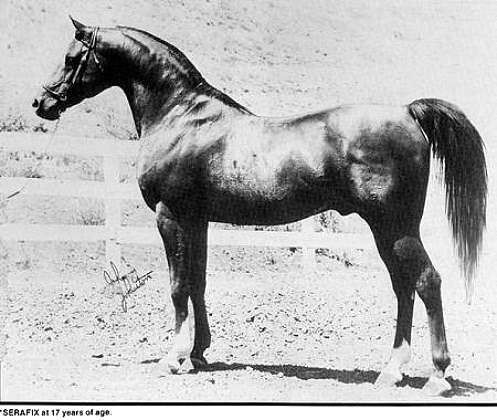
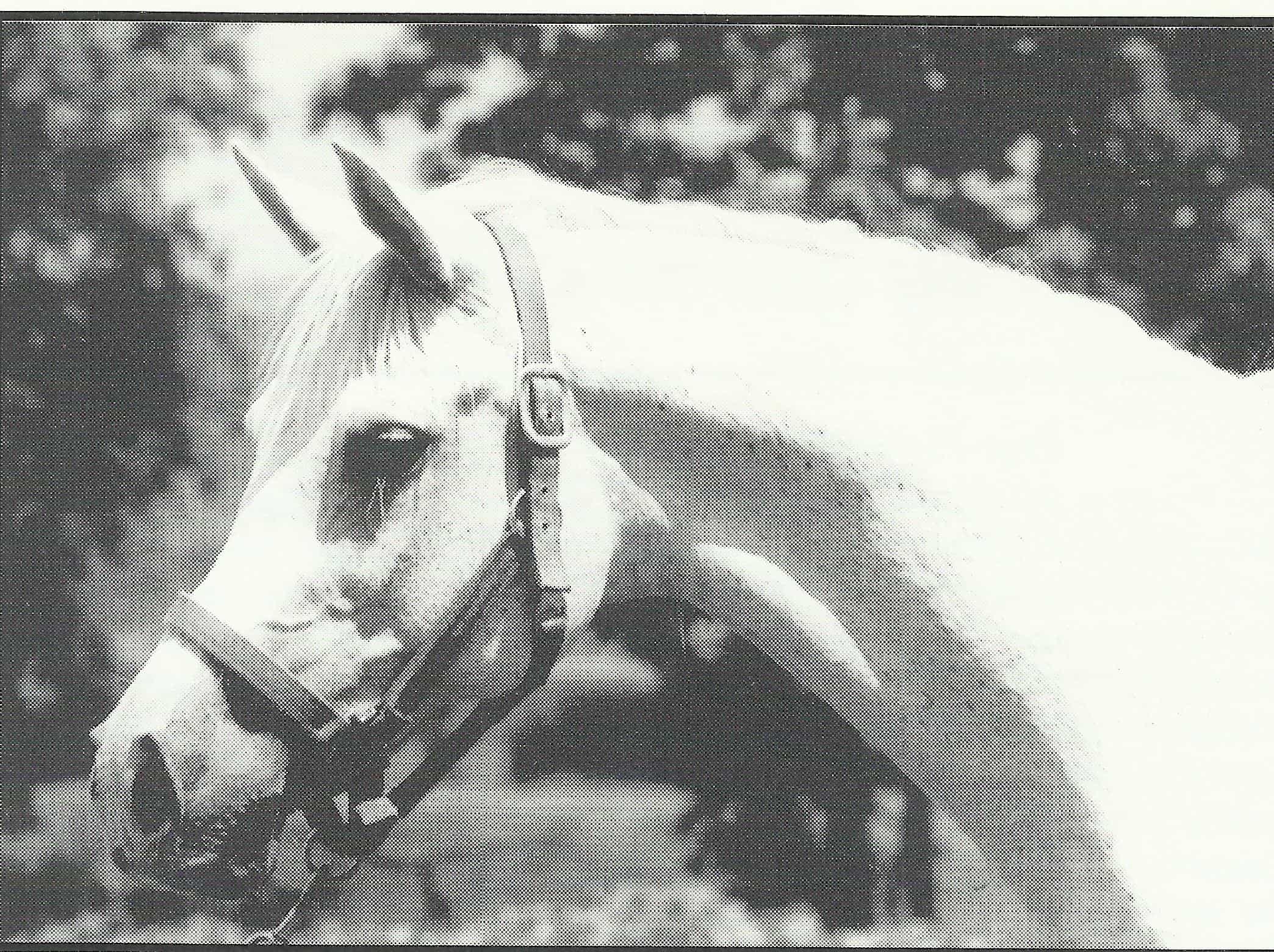

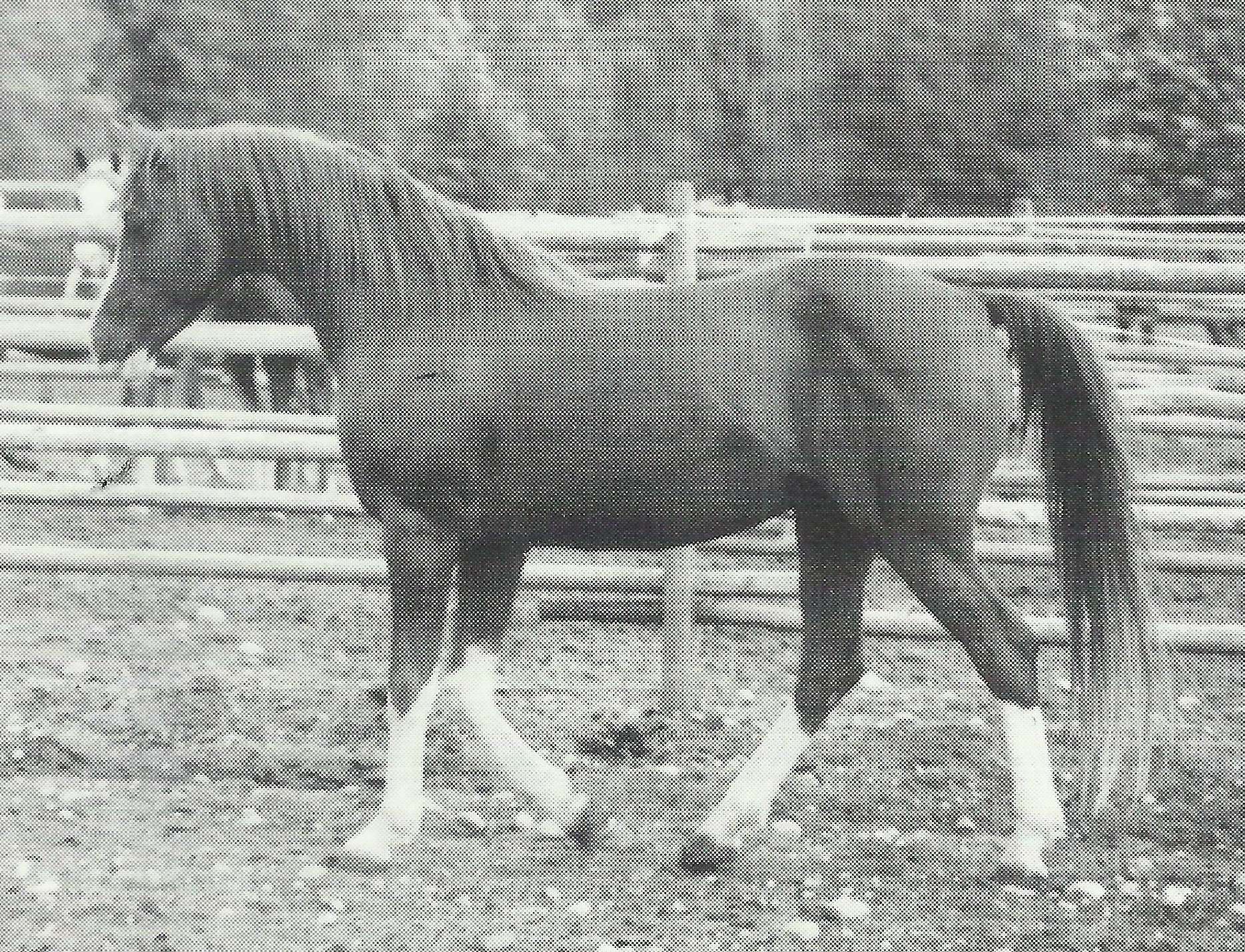
Comments
No Comments